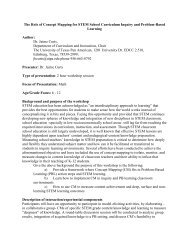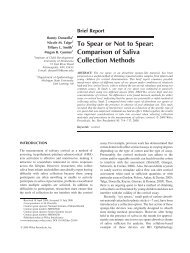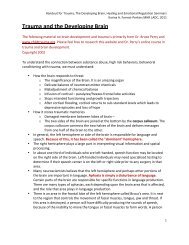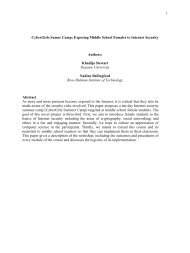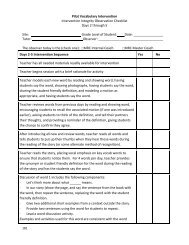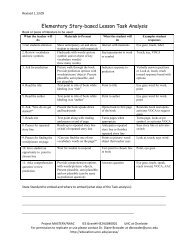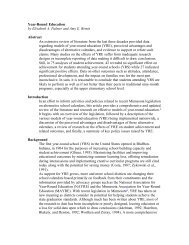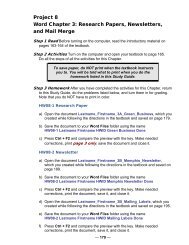Introduction to Positive Ways of Intervening with Challenging Behavior
Introduction to Positive Ways of Intervening with Challenging Behavior
Introduction to Positive Ways of Intervening with Challenging Behavior
You also want an ePaper? Increase the reach of your titles
YUMPU automatically turns print PDFs into web optimized ePapers that Google loves.
How do I shape a behavior which the student does not exhibit in any form?<br />
Interpret any action which can be approximated as any form <strong>of</strong> the behavior as the behavior itself and reinforce it.<br />
For example, if your goal is that a shy student participate in class discussion, interpret any movement <strong>of</strong> his hand<br />
as raising his hand. “Tom, you wanted <strong>to</strong> say something? Did you agree <strong>with</strong> the author's opinion?” Posing<br />
questions such as this make it easy for the student <strong>to</strong> participate as they require only a “yes” or “no” answer. After<br />
Tom answers, you can reinforce him by asking, "How many people agree <strong>with</strong> Tom? (hands go up) Wanda, why<br />
do you agree <strong>with</strong> Tom?" This gives the student important peer reinforcement.<br />
Another example <strong>of</strong> shaping a new behavior is that <strong>of</strong> in-seat behavior. If a student is invariably out <strong>of</strong> her<br />
seat, catch her in her seat and reinforce her for it. "Sharisse, you've been sitting quietly in your seat. How would<br />
you like <strong>to</strong> help me hand out worksheets?"<br />
What are the advantages <strong>of</strong> shaping?<br />
The biggest advantage <strong>of</strong> shaping is that it focuses your attention and the student's attention on positive behavior.<br />
It recognizes progress and helps the student feel good about him- or herself. It creates the opportunity for positive<br />
interaction between the student and teacher, something which may not be that common for a student who exhibits<br />
high rates <strong>of</strong> problem behavior. Additionally, the effects <strong>of</strong> shaping are long lasting and become a solid part <strong>of</strong> the<br />
students reper<strong>to</strong>ire.<br />
Shaping is easy <strong>to</strong> implement and, since reinforcement is natural, it does not draw undue attention <strong>to</strong> the<br />
process <strong>of</strong> behavior modification. This may be very important in specific cases, such as drawing out shy students,<br />
or <strong>with</strong> some high school students.<br />
Are there any precautions <strong>to</strong> be considered before implementing a shaping program?<br />
Yes. Remember that shaping is a slow process and that achieving steps which are very small, in light <strong>of</strong> the end<br />
goal may take quite some time. Don't give up! Give the process and the student the time needed <strong>to</strong> change.<br />
If change is not occurring <strong>to</strong> the degree you had hoped, perhaps the steps you have set are <strong>to</strong>o big and need <strong>to</strong><br />
be reevaluated or perhaps there are other behaviors which are interfering <strong>with</strong> your goals which need <strong>to</strong> be<br />
modified first.<br />
Be sure that each situation you reinforce will be interpreted by the student as positive reinforcement. It is the<br />
student's interpretation <strong>of</strong> your reinforcement which motivates him or her <strong>to</strong> change. For example, if you<br />
are attempting <strong>to</strong> draw out a shy student, be sure that he or she is paying attention when you elicit his or her<br />
opinion. If you inadvertently ask for participation when the student is not paying attention, he or she may interpret<br />
your actions as an attempt <strong>to</strong> humiliate him or her and <strong>with</strong>draw even further.<br />
References<br />
Axelrod, S. (1977). <strong>Behavior</strong> modification for the classroom teacher. McGraw-Hill Book Company.<br />
Burke, J.C. (1992). Decreasing classroom behavior problems: Practical guidelines for teachers. San Diego: Singular Publishing<br />
Group, Inc.<br />
Cangelosi, J.S. (1988). Classroom management strategies: Gaining and maintaining students' cooperation. Longman, Inc.<br />
Collins, M.M., & Fontenelle, D.H. (1982). Changing student behaviors: A positive approach. Cambridge, MA: Schenkman Publishing<br />
Company, Inc.<br />
LaVigna, G.W., & Donnellan, A.M. (1986). Alternative <strong>to</strong> punishment: Solving behavior problems <strong>with</strong> non-aversive strategies.<br />
Irving<strong>to</strong>n Publishers.<br />
O'Leary, K.D., & O'Leary, S.G. (1971). Classroom management: The successful use <strong>of</strong> behavior modification, 2nd edition. New<br />
York: Pergamon Press Inc.<br />
Walden, E.L., & Thompson, S.A. (1981). Review <strong>of</strong> some alternative approaches <strong>to</strong> drug management <strong>of</strong> hyperactivity in children.<br />
Journal <strong>of</strong> Learning Disabilities, 14, 213-217.<br />
This publication was supported by Grant #H029K20171, Special Project <strong>to</strong> Provide Technical Assistance, Inservice Training<br />
and Site Development for <strong>Positive</strong> <strong>Behavior</strong>al Support Strategies for Students <strong>with</strong> Disabilities from the U.S. Department <strong>of</strong><br />
Education. The University <strong>of</strong> Minnesota is an equal opportunity employer and educa<strong>to</strong>r.




